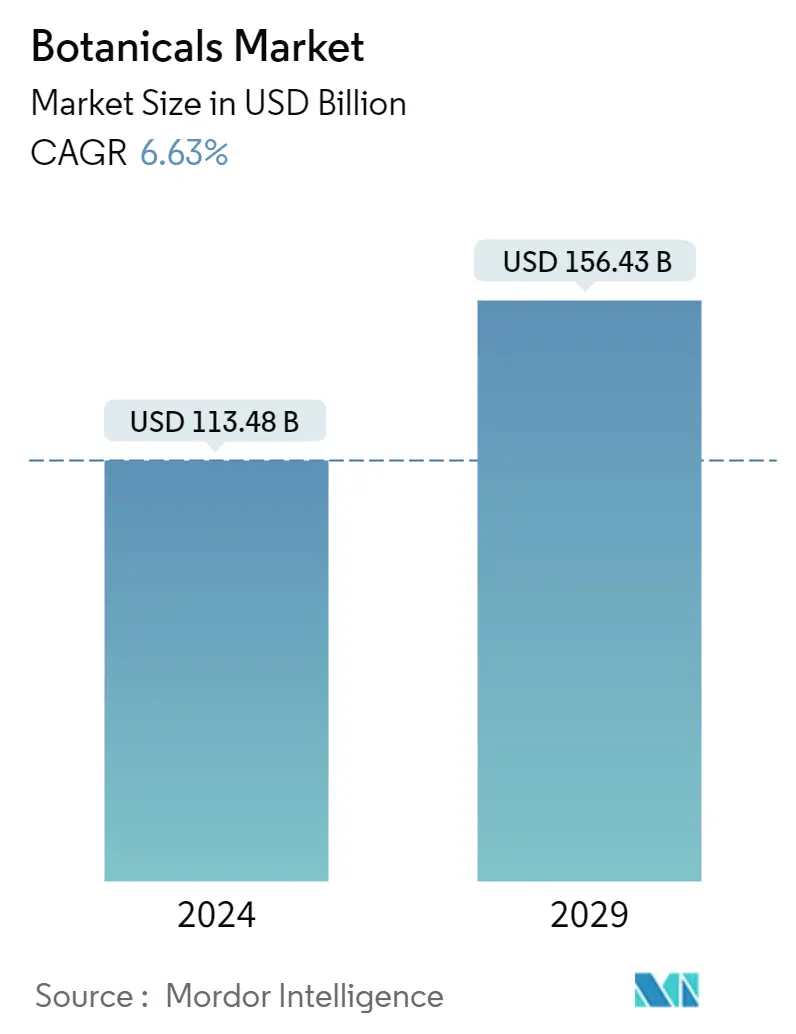Market Size of Botanicals Industry

| Study Period | 2019 - 2029 |
| Market Size (2024) | USD 113.48 Billion |
| Market Size (2029) | USD 156.43 Billion |
| CAGR (2024 - 2029) | 6.63 % |
| Fastest Growing Market | Europe |
| Largest Market | North America |
Major Players
*Disclaimer: Major Players sorted in no particular order |
Botanical Market Analysis
The Botanicals Market size is estimated at USD 113.48 billion in 2024, and is expected to reach USD 156.43 billion by 2029, growing at a CAGR of 6.63% during the forecast period (2024-2029).
Botanicals have very efficient medical properties. Botanicals are derived from plants. Specifically, in the health and wellness field, this term refers to plants or parts of plants with medicinal value or health benefits. Botanicals are modified into botanical preparations, botanical drugs, and essential oils. With rising concerns about the safety, cost, and adverse effects of conventional pharmaceutical drugs, these are gaining popularity. Botanical health products are now widely available Botanicals are derived from plants. Specifically, in the health and wellness field, this term refers to plants or parts of plants with medicinal value or health benefits. Botanicals are modified into botanical preparations, botanical drugs, and essential oils. With rising concerns about the safety, cost, and adverse effects of conventional pharmaceutical drugs, these are gaining popularity. Botanical health products are now widely available. Rising health consciousness has increased concerns over diet, and enhanced care towards preventive healthcare has made consumers use botanicals. After the COVID-19 pandemic, people have become very health conscious, and they are more keen on using products that have medical properties. Furthermore, the emergence of new application areas, such as functional beverages, in accordance with the evolution of consumer needs opens doors for new product development opportunities. Consumers who want clean-label and sustainable ingredients are attracted to products that contain botanicals. However, the use of botanical ingredients, such as sage leaf and rose petal, is also growing in categories including bakery, dairy, and confectionery. Among foods and beverages, consumers tend to consider botanical "premium" ingredients. Local palates and availability dictate which botanicals are most popular. Botanical extracts can be found in a growing number of product launches across all major segments, from beverages to baked goods and dairy products to savory categories such as soups, sauces, and snacks. Likewise, they are set to play a bigger role in plant-based dairy and meat alternatives since they provide both sensory value and transparency in terms of product labeling.
Botanical Industry Segmentation
Botanical ingredients include natural ingredients extracted from or derived from herbs, spices, flowers, seeds, leaves, and fruits. Many extracts and oils have incredible healing and rejuvenating properties that work wonders for a range of skin issues, from hyperpigmentation and acne to aging concerns. The market studied is segmented by sources, applications, and geography. By source, the market studied is segmented into herbs, spices, flowers, and other sources. By application, the market studied is segmented into food and beverage, dietary supplements, animal feed, and other applications. Bakery and confectionery, sauces and dressings, functional beverages, and other food and beverages are sub-segments of the food and beverage segment. By geography, the market studied has been segmented into North America, Europe, Asia-Pacific, South America, and the Middle East and Africa. For each segment, the market sizing and forecasting have been done in value terms (USD million).
| By Source | |
| Herbs | |
| Spices | |
| Flowers | |
| Other Sources |
| By Application | ||||||
| ||||||
| Dietary Supplements | ||||||
| Animal Feed | ||||||
| Other Applications |
| By Geography | |||||||||
| |||||||||
| |||||||||
| |||||||||
| |||||||||
|
Botanicals Market Size Summary
The botanicals market is experiencing significant growth, driven by increasing consumer awareness and demand for natural and sustainable products. Botanicals, derived from plants, are gaining popularity in the health and wellness sector due to their medicinal properties and benefits. This trend is fueled by rising concerns over the safety and side effects of conventional pharmaceuticals, leading consumers to seek botanical alternatives. The market is witnessing a surge in the use of botanical ingredients across various food and beverage categories, including functional beverages, plant-based dairy, and meat alternatives. The concept of clean eating and the demand for transparency in sourcing and labeling are further propelling the market, as consumers increasingly prefer products with clean labels and sustainable ingredients.
In Europe, the botanicals market is robust, with a significant share in botanical extracts like essential oils, spices, and herbs. The region's consumer preferences for organic and natural products are driving demand, particularly in the food and cosmetics industries. Companies are innovating and expanding their product lines to meet the growing consumer demand for botanical ingredients. The market is characterized by fragmentation, with numerous global and regional players, including major companies like International Flavors & Fragrances Inc., Bell Flavors & Fragrances, and Givaudan, leading the way with extensive product offerings and strategic growth initiatives. These companies are focusing on product innovation and expanding production capacities to cater to a diverse consumer base, ensuring continued market growth and development.
Botanicals Market Size - Table of Contents
-
1. MARKET DYNAMICS
-
1.1 Market Drivers
-
1.2 Market Restraints
-
1.3 Porter's Five Forces Analysis
-
1.3.1 Threat of New Entrants
-
1.3.2 Bargaining Power of Buyers/Consumers
-
1.3.3 Bargaining Power of Suppliers
-
1.3.4 Threat of Substitute Products
-
1.3.5 Intensity of Competitive Rivalry
-
-
-
2. MARKET SEGMENTATION
-
2.1 By Source
-
2.1.1 Herbs
-
2.1.2 Spices
-
2.1.3 Flowers
-
2.1.4 Other Sources
-
-
2.2 By Application
-
2.2.1 Food and Beverage
-
2.2.1.1 Bakery and Confectionery
-
2.2.1.2 Sauces and Dressings
-
2.2.1.3 Functional Beverages
-
2.2.1.4 Other Food and Beverages
-
-
2.2.2 Dietary Supplements
-
2.2.3 Animal Feed
-
2.2.4 Other Applications
-
-
2.3 By Geography
-
2.3.1 North America
-
2.3.1.1 United States
-
2.3.1.2 Canada
-
2.3.1.3 Mexico
-
2.3.1.4 Rest of North America
-
-
2.3.2 Europe
-
2.3.2.1 Spain
-
2.3.2.2 United Kingdom
-
2.3.2.3 France
-
2.3.2.4 Germany
-
2.3.2.5 Italy
-
2.3.2.6 Russia
-
2.3.2.7 Rest of Europe
-
-
2.3.3 Asia-Pacific
-
2.3.3.1 China
-
2.3.3.2 India
-
2.3.3.3 Japan
-
2.3.3.4 Australia
-
2.3.3.5 Rest of Asia-Pacific
-
-
2.3.4 South America
-
2.3.4.1 Brazil
-
2.3.4.2 Argentina
-
2.3.4.3 Rest of South America
-
-
2.3.5 Middle-East and Africa
-
2.3.5.1 Saudi Arabia
-
2.3.5.2 South Africa
-
2.3.5.3 Rest of Middle-East and Africa
-
-
-
Botanicals Market Size FAQs
How big is the Botanicals Market?
The Botanicals Market size is expected to reach USD 113.48 billion in 2024 and grow at a CAGR of 6.63% to reach USD 156.43 billion by 2029.
What is the current Botanicals Market size?
In 2024, the Botanicals Market size is expected to reach USD 113.48 billion.

